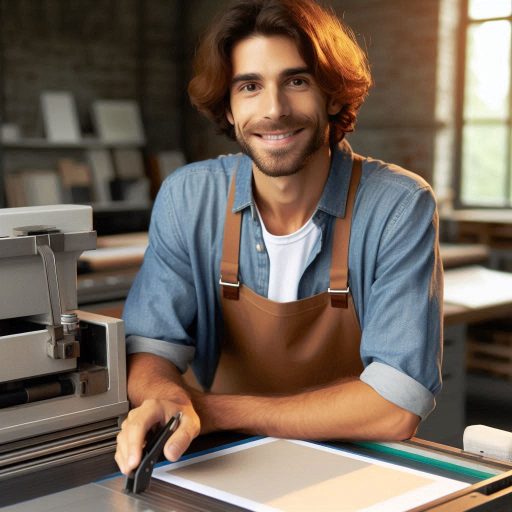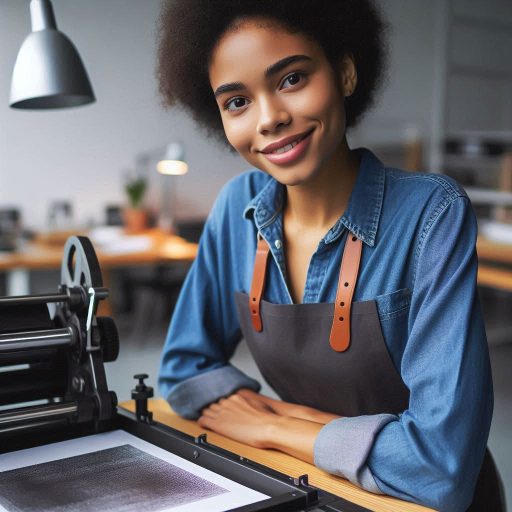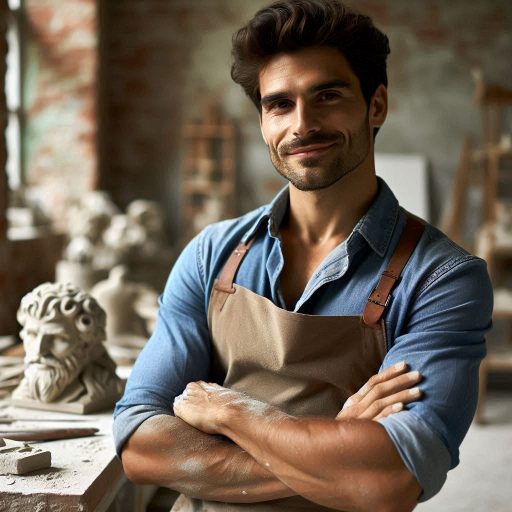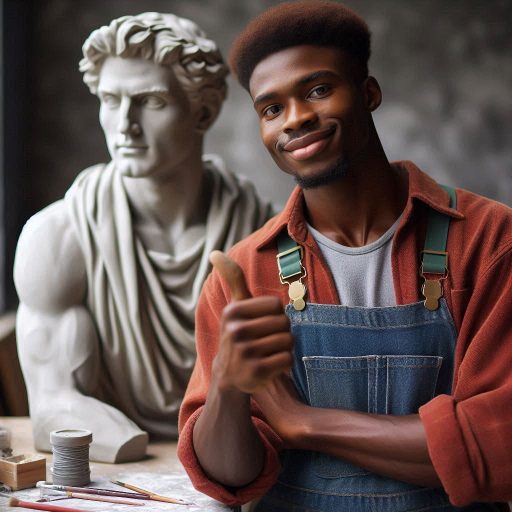Introduction
Choosing the right materials for sculptures is crucial for achieving desired artistic outcomes.
The selection impacts durability, texture, and overall aesthetic appeal.
Factors to consider include:
- Durability: Materials should withstand environmental conditions.
- Texture: Determines the tactile quality and finish of the sculpture.
- Aesthetic Appeal: Material choice influences visual impact and artistic expression.
Selecting sculpture materials involves understanding their properties and how they interact with artistic vision.
Each material offers unique characteristics that can enhance or limit creative possibilities.
By carefully considering these factors, sculptors ensure their artworks endure and resonate with viewers.
This section will delve into various types of sculpture materials, their pros and cons, and practical tips for choosing the best ones suited to artistic goals.
Types of Sculpture Materials
Sculpture materials come in various forms, each offering unique attributes for artistic expression.
Understanding these materials is essential for choosing the right one for your project.
Overview of Different Types of Materials
Sculptors use a wide range of materials, each suited to different techniques and styles.
Commonly used materials include metal, stone, wood, clay, and mixed media.
Each material offers distinct properties that influence the final artwork’s look and feel.
Categories: Metal, Stone, Wood, Clay, and Mixed Media
- Metal: This category includes materials like bronze, steel, and aluminum
Metals are known for their durability and ability to hold fine details.
Sculptors often use them for both indoor and outdoor pieces.
Metal sculptures can be cast, welded, or forged. - Stone: Stone materials, such as marble and limestone, have been used in sculpture for centuries.
They are valued for their permanence and texture.
Carving stone requires specialized tools and techniques, but it yields timeless, elegant results. - Wood: Wood is a versatile material that can be carved or assembled.
It offers a natural warmth and can be manipulated with relative ease.
Common woods include oak, maple, and cherry.
Wood sculptures often evoke a sense of organic beauty. - Clay: Clay is favored for its malleability and ease of shaping.
It is often used for preliminary models or large-scale sculptures.
Once sculpted, clay pieces can be fired in a kiln to become ceramics, or left as raw clay for a more earthy finish. - Mixed Media: This category includes any combination of materials, allowing for creative experimentation.
Artists might combine metal with wood or clay with found objects.
Mixed media sculptures offer endless possibilities for innovation and personal expression.
Brief Description of Key Characteristics
Each material has its strengths and challenges.
Metal provides strength and longevity but requires skillful handling.
Stone demands patience and precision, while wood offers warmth but may not last outdoors.
Clay is easy to shape but needs to be fired for durability.
Mixed media allows for creativity but can be complex to execute.
Understanding these materials helps sculptors make informed choices, leading to successful and impactful artworks.
Read: The Future of Printmaking in Digital Age
Factors to Consider when Choosing Sculpture Materials
Factors like durability, workability, cost, and availability
Choosing the right material for a sculpture involves several key factors.
Transform Your Career Today
Unlock a personalized career strategy that drives real results. Get tailored advice and a roadmap designed just for you.
Start NowDurability is crucial; the material must withstand environmental conditions over time.
For outdoor sculptures, opt for materials like bronze or stone that resist weathering.
For indoor pieces, materials like wood or clay may suffice.
Workability is another important factor.
Some materials, like marble or wood, are easier to carve and shape.
Others, like metal or glass, require specialized tools and skills.
Consider your expertise and the tools available when selecting a material.
Cost is a significant consideration.
Materials vary greatly in price.
Bronze, for example, is more expensive than concrete or clay.
Budget constraints may limit your options, so choose a material that fits your financial plan without compromising quality.
Availability affects your material choice as well.
Some materials may be hard to find or require special orders.
Ensure that the material you choose is readily available or can be sourced easily to avoid delays.
Importance of considering the intended location and environment of the sculpture
The intended location and environment of the sculpture are vital.
Sculptures exposed to the elements need weather-resistant materials.
For indoor displays, you can use a wider range of materials, including delicate or intricate options.
Tips on matching the material to the artistic vision and style of the sculpture
Matching the material to the artistic vision and style of the sculpture enhances its impact.
A modern abstract piece might benefit from sleek metal or glass, while a classical statue could be best suited to marble or bronze.
Align the material with your artistic goals to ensure the sculpture’s success.
Transform Your Career Today
Unlock a personalized career strategy that drives real results. Get tailored advice and a roadmap designed just for you.
Start NowIn a nutshell, choosing the right sculpture material involves balancing durability, workability, cost, and availability.
Consider the sculpture’s location and environment, and match the material to your artistic vision.
With careful selection, your sculpture will stand the test of time and align perfectly with your creative intent.
Your artistic vision to life but also ensure the longevity and quality of your artwork.
Read: Printmaking Techniques: Woodcut and Linocut
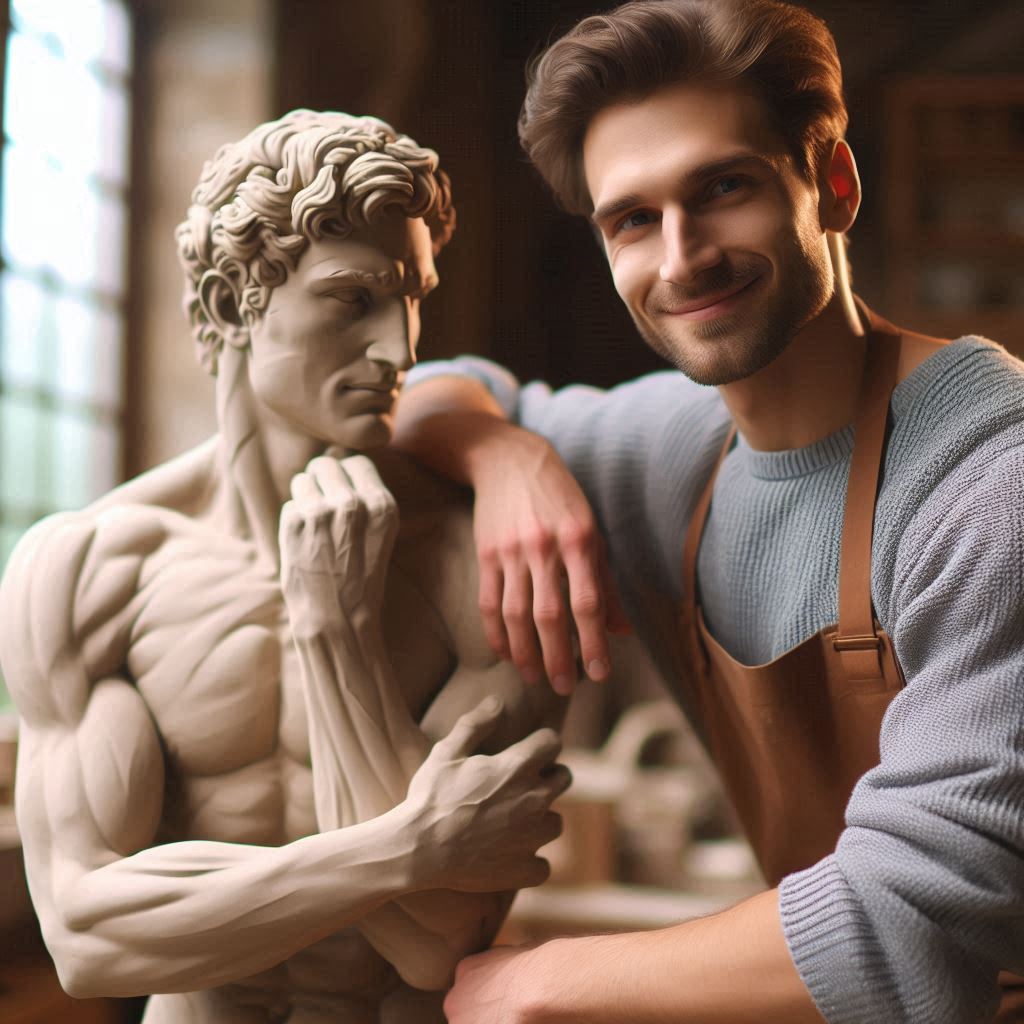
Metal Sculpture Materials
The Different Types of Metals Used for Sculptures
Metals are popular in sculpture for their durability and versatility.
Common metals include bronze, steel, and aluminum.
Bronze, an alloy of copper and tin, is renowned for its strength and timeless quality.
Steel, a strong and flexible material, is often used for contemporary works.
Aluminum is lightweight and resistant to corrosion, making it a practical choice.
Benefits and Limitations of Working with Metals Like Bronze, Steel, and Aluminum
Bronze offers a classic, timeless appeal.
Its durability ensures sculptures withstand the elements, while its ability to capture fine details adds artistic depth.
However, bronze can be expensive and requires careful maintenance to prevent oxidation.
Steel is strong and versatile.
It can be welded and shaped into intricate forms, making it suitable for modern designs.
Steel’s main drawback is its susceptibility to rust, which requires regular maintenance or protective coatings.
Aluminum is lightweight and resistant to rust.
This makes it ideal for large sculptures that need to be moved or installed in various environments.
However, aluminum’s softness can limit its ability to hold fine details and make it less suitable for intricate designs.
Tips on Selecting the Right Metal Based on Desired Aesthetics and Budget
When choosing a metal for your sculpture, consider both aesthetic goals and budget constraints.
Transform Your Career Today
Unlock a personalized career strategy that drives real results. Get tailored advice and a roadmap designed just for you.
Start NowFor a classic look and high durability, bronze is an excellent choice if the budget allows.
If you seek flexibility and modern design, steel offers both creativity and strength, though it may require maintenance.
For lightweight and corrosion-resistant sculptures, aluminum is ideal, particularly if budget is a concern.
In summary, selecting the right metal involves balancing aesthetic desires with practical considerations.
Evaluate each metal’s characteristics and how they align with your project goals to make an informed choice.
Read: The Impact of Public Art Sculptures on Communities
Stone Sculpture Materials
Overview of Popular Types of Stones Used for Sculpting
Stone has been a timeless medium for sculptors.
Popular choices include marble, granite, and soapstone.
Marble, prized for its fine grain and translucence, is ideal for detailed, classical sculptures.
Granite, with its durability and variety of colors, suits large, modern works.
Soapstone, softer and easier to carve, is favored for intricate designs and smaller sculptures.
Characteristics of Each Type of Stone and Their Suitability for Different Projects
Marble is renowned for its smooth texture and ability to polish to a high sheen.
It is perfect for capturing fine details, making it a favorite for classical and realistic sculptures.
Granite, being incredibly hard, requires more effort to sculpt but provides a sturdy and long-lasting finish.
It works well for monuments and large-scale projects.
Soapstone’s softness allows for easier carving and smoother finishes, making it ideal for detailed work and abstract forms.
Each stone’s characteristics guide its suitability for various artistic visions and practical applications.
Tips on Sourcing Quality Stone Materials and Tools for Sculpting
When sourcing stone, select a reputable supplier to ensure quality.
Look for stones with consistent texture and minimal flaws.
Inspect samples before purchasing to gauge their suitability for your project.
Transform Your Career Today
Unlock a personalized career strategy that drives real results. Get tailored advice and a roadmap designed just for you.
Start NowInvest in quality sculpting tools, including chisels, hammers, and rasps.
Using the right tools for the stone type improves your efficiency and the final result.
Regular maintenance of your tools is also crucial for precision and longevity.
By choosing high-quality materials and tools, you enhance both the process and the outcome of your sculpting endeavors.
Read: Exploring Printmaking in Public Art Projects
Wood Sculpture Materials
When choosing wood for sculpture, understanding the types, characteristics, and selection criteria is crucial.
Each type of wood brings unique qualities to a sculpture, influencing both the carving process and the final outcome.
Different Types of Wood Commonly Used for Carving Sculptures
Several types of wood are favored for carving sculptures.
Basswood is popular due to its softness and ease of carving.
It holds detail well and is less likely to splinter.
Linden wood, similar to basswood, is valued for its uniform texture and smooth surface.
Cherry wood is denser and more challenging to carve but offers a beautiful finish and rich color.
Walnut is another choice, known for its deep, dark hues and durability.
Each wood type has distinct properties that affect the sculpting process and final appearance.
The Grain, Texture, and Color Variations of Various Wood Species
Wood grain, texture, and color can greatly affect a sculpture’s aesthetic.
Basswood features a fine, even grain that makes it easy to work with but lacks dramatic color variation.
Linden wood also has a consistent grain, ideal for detailed carving.
Cherry wood has a fine grain and rich color that darkens with age, adding character to the sculpture.
Walnut, with its pronounced grain patterns and dark tones, provides a dramatic and elegant appearance.
Understanding these variations helps in selecting the right wood for the desired visual effect.
Transform Your Career Today
Unlock a personalized career strategy that drives real results. Get tailored advice and a roadmap designed just for you.
Start NowTips on Selecting the Right Wood Based on Hardness, Flexibility, and Carving Ease
Choosing the right wood involves considering hardness, flexibility, and carving ease.
Softer woods like basswood and linden are easier to carve, making them suitable for intricate designs.
Harder woods, such as cherry and walnut, offer durability but require more effort and specialized tools.
Flexibility in wood impacts how it responds to carving techniques.
Test a small piece of the wood to gauge its workability and ensure it meets your project’s requirements.
Proper selection ensures the carving process is smooth and the final sculpture meets your artistic vision.
Clay Sculpture Materials
When sculpting with clay, the type you choose affects your final piece’s appearance and durability.
This guide explores earthenware, stoneware, and polymer clay.
Overview of Different Types of Clay
Earthenware is a popular choice for beginners and artists alike.
It’s easily workable and has a warm, natural color.
Stoneware is known for its durability and versatility.
It can handle high temperatures, making it ideal for functional pieces.
Polymer clay, unlike the others, is synthetic. It remains soft until baked, allowing intricate detail work.
Properties and Firing Requirements
Earthenware clay is fired at lower temperatures, usually between 1,000°C and 1,150°C.
It’s porous and less durable unless glazed.
Stoneware, fired at higher temperatures (1,200°C to 1,300°C), becomes non-porous and robust, suitable for both art and functional objects.
Polymer clay doesn’t require a kiln. Instead, you bake it in a conventional oven at 130°C.
This makes it accessible for home-based sculptors.
Tips for Choosing the Right Clay
Select clay based on your project’s needs.
For detailed, intricate designs, polymer clay is ideal due to its fine texture and ease of handling.
Transform Your Career Today
Unlock a personalized career strategy that drives real results. Get tailored advice and a roadmap designed just for you.
Start NowChoose earthenware if you want a rustic, traditional look or are creating decorative items that don’t require extreme durability.
Opt for stoneware for functional pieces like mugs or vases that need to withstand everyday use and higher temperatures.
Each clay type brings unique qualities to your work, influencing texture, color, and strength.
Choosing the right clay enhances your creative expression and ensures your sculpture meets your intended design and function.
Consider these factors carefully to achieve the best results in your sculpting projects.
Mixed Media Sculpture Materials
Combining different materials like metal, wood, and clay in sculptures
One of the exciting ways to create sculptures is by utilizing mixed media, which involves combining different materials such as metal, wood, and clay.
This approach offers a diverse range of possibilities for artists to explore and experiment with.
Benefits of using mixed media for creating unique textures, colors, and visual interest
Benefits of using mixed media in sculpture include the ability to achieve unique textures, colors, and visual interest that may not be possible with a single material.
By incorporating various elements, artists can add depth and dimension to their creations, making them captivating and dynamic.
Tips on experimenting with mixed media to enhance creativity and storytelling in sculptures
Experimenting with mixed media allows artists to push the boundaries of creativity and storytelling in their sculptures.
By blending different materials, artists can convey intricate narratives and emotions, adding layers of meaning to their work.
This approach encourages artists to think outside the box and innovate in their artistic expression.
Tips for artists looking to work with mixed media in their sculptures include starting with a clear concept or idea to guide the combination of materials.
It is essential to consider how each material will interact with others and contribute to the overall composition.
Experimentation and play are key elements in creating unique and compelling sculptures using mixed media.
Another tip is to embrace the imperfections and unexpected outcomes that may arise when working with mixed media.
These elements can add authenticity and character to the artwork, making it more engaging and intriguing to viewers.
Embracing the unpredictability of different materials can lead to surprising and innovative results in sculpture.
Furthermore, artists can find inspiration for mixed media sculptures in everyday objects, nature, and architectural elements.
By observing the world around them, artists can gather ideas for incorporating different materials and textures into their sculptures.
Transform Your Career Today
Unlock a personalized career strategy that drives real results. Get tailored advice and a roadmap designed just for you.
Start NowDrawing from various sources can help artists create diverse and visually striking artworks that resonate with viewers.
Overall, mixed media sculpture offers a versatile and dynamic approach to creating art that allows artists to push their creative boundaries and explore new possibilities.
By combining different materials, textures, and colors, artists can craft sculptures that are visually captivating, emotionally resonant, and thought-provoking.
Experimentation, storytelling, and innovation are key components in mastering the art of mixed media sculpture.
Conclusion
Choosing the right materials for sculptures is crucial for achieving the desired artistic vision.
The material affects the texture, durability, and overall impact of the sculpture.
It can influence how light interacts with the surface and how the piece ages over time.
Exploring various materials and techniques can greatly enhance artistic expression.
Each material—whether it’s marble, bronze, or wood—offers unique characteristics that can bring different aspects of your vision to life.
Experimenting with diverse materials allows you to discover new ways to convey your artistic ideas.
Consider how different materials align with your artistic goals.
For instance, bronze offers a classic, timeless quality, while glass can provide a modern, translucent effect.
Understanding these properties helps in making informed decisions that elevate the sculpture’s impact.
The choice of material also affects the longevity of your artwork.
Durable materials like granite or bronze ensure that sculptures withstand environmental factors and remain impressive for years.
Conversely, more delicate materials might require additional care but can produce equally captivating results.
Selecting the right materials is integral to sculptural success.
It impacts both the aesthetic and practical aspects of the artwork.
By experimenting with various options, you can enhance your artistic expression and ensure that your sculptures not only captivate but also endure.

